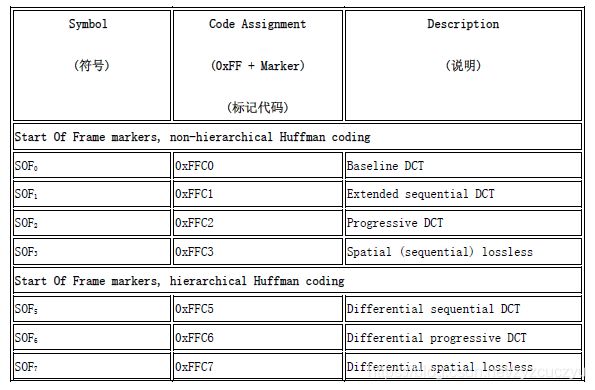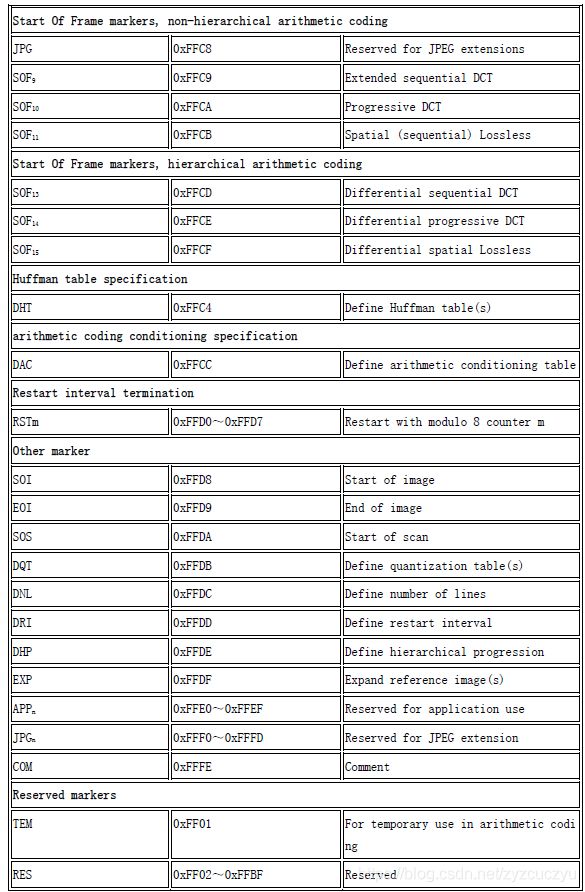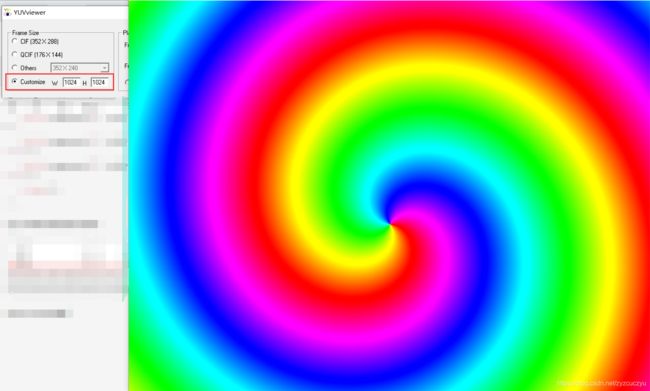【数据压缩(八)】JPEG原理分析及JPEG解码器的调试
JPEG原理分析及JPEG解码器的调试
- 一、实验目的
- 二、实验内容
-
- 1、JPEG编解码原理
-
- (1)零偏置电平下移
- (2)8x8 DCT
- (3)量化
- (4)直流DC系数的DPCM编码
- (5)AC系数的Z字扫描
- (6)Huffman编码
-
- ①DC系数的Huffman编码
- ②AC系数的Huffman编码
- 2、JPEG文件格式
-
- (1)Segment的组织形式
- (2)JPEG的Segment Market
- 三、实验步骤
-
- 0、程序准备
- 1、运行JPEG解码程序,并输出可供YUVviewer观看的YUV文件
- 2、程序调试过程的理解
-
- (1)理解程序设计的整体框架
- (2)理解三个结构体的设计目的
-
- ①`struct huffman_table`
- ②`struct component`
- ③`struct jdec_private`
- (3)理解在视音频编解码调试中TRACE的目的和含义
- 3、输出量化矩阵和Huffman码表
-
- (1)量化矩阵
- (2)Huffman码表
- (3)输出结果
- 四、实验结论
一、实验目的
- 掌握JPEG编解码系统的基本原理。
- 初步掌握复杂的数据压缩算法实现,并能根据理论分析需要实现所对应数据的输出。
二、实验内容
1、JPEG编解码原理

JPEG编码过程如上图所示,解码是编码的逆过程。下面以编码为例进行分析。
(1)零偏置电平下移
- 操作:先对8×8的像块进行零偏置电平下移(Level Offset)。即对于灰度级是2n的像素,通过减去 2n-1,将无符号的整数值变成有符号数。
- 目的: 使像素的绝对值出现 3 位 10 进制的概率大大减少。
- 对于n=8,即将0~255的值域,通过减去128转换为值域在-128~127之间的值
(2)8x8 DCT
(3)量化
- 因为人眼对亮度信号比对色差信号更敏感,因此使用了两种量化表:亮度量化值和色差量化值。
- 根据人眼的视觉特性(对低频敏感,对高频不太敏感)对低频分量采取较细的量化,对高频分量采取较粗的量化。
- 如果原始图象中细节丰富,则去掉的数据较多,量化后的系数与量化前差别较大。反之,细节少的原始图象在压缩时去掉的数据少些,量化后的系数与量化前差别较小。

(4)直流DC系数的DPCM编码
由于8×8图像块经过DCT变换之后得到的DC直流系数有两个特点:
- 系数的数值比较大
- 相邻 8 × 8 图像块的 DC 系数值变化不大:冗余
根据这个特点,JPEG算法使用了差分脉冲调制编码(DPCM)技术,对相邻图像块之间量化DC系数的差值DIFF进行编码:
D I F F k = D C k − D C k − 1 DIFF_k=DC_k-DC_{k-1} DIFFk=DCk−DCk−1
(5)AC系数的Z字扫描
- 由于经DCT变换后,系数大多数集中在左上角,即低频分量区,因此采用Z字形按频率的高低顺序读出,可以出现很多连零的机会。可以使用游程编码。尤其在最后,如果都是零,给出EOB (End of Block)即可。
- 然后,系数序列分组,将非零系数和它前面的相邻的全部零系数分在一组内;每组用两个符号表示 [(Run, Size), (Amplitude)]
Amplitude:表示非零系数的幅度值;
Run:表示零的游程即零的个数;
Size:表示非零系数的幅度值的编码位数。
(6)Huffman编码
①DC系数的Huffman编码
②AC系数的Huffman编码
- 在JPEG和MPEG编码种规定:(run, level)表示连续run个0,后面跟值为level的系数。
- 编码时,run最大为15,用4位表示RRRR;level编码类似DC,分成16个类别,用4位表示,SSSS表示类别号,再加上类内索引进行编码。对(RRRR,SSSS)联合用Huffman编码;对类内索引采用定长编码。
- AC系数Huffman编码举例:

2、JPEG文件格式
(1)Segment的组织形式
JPEG在文件中以Segment的形式组织 ,它具有以下特点:
- 均以0xFF开始,后跟1byte的Marker和2byte的Segment length(包含表示Length本身所占用的2byte,不含0xFF+Marker所占用的2byte);
- 采用 Motorola序(相对于Intel序),即保存时高位在前,低位在后;
- Data部分中,0xFF后若为0x00,则跳过此字节不予处理。
(2)JPEG的Segment Market
三、实验步骤
0、程序准备
遵循程序要求,在调试属性内设定好命令参数。
- 第一个参数为要解码的jpg文件;
- 第二个参数为功能选项,此处选择yuv420p,即转换为yuv420格式的文件;
- 第三个参数为输出文件。
1、运行JPEG解码程序,并输出可供YUVviewer观看的YUV文件
观察调试解码程序发现,Y、U、V分量输出过程在如下所示的函数内,在//输出yuv文件后增加一段程序输出YUV文件。再次运行程序。
/**
* Save a buffer in three files (.Y, .U, .V) useable by yuvsplittoppm
*/
static void write_yuv(const char* filename, int width, int height, unsigned char** components)
{
FILE* F;
char temp[1024];
snprintf(temp, 1024, "%s.Y", filename);
F = fopen(temp, "wb");
fwrite(components[0], width, height, F);
fclose(F);
snprintf(temp, 1024, "%s.U", filename);
F = fopen(temp, "wb");
fwrite(components[1], width * height / 4, 1, F);
fclose(F);
snprintf(temp, 1024, "%s.V", filename);
F = fopen(temp, "wb");
fwrite(components[2], width * height / 4, 1, F);
fclose(F);
//输出yuv文件
snprintf(temp, 1024, "%s.yuv", filename);
F = fopen(temp, "wb");
fwrite(components[0], width, height, F);
fwrite(components[1], width * height / 4, 1, F);
fwrite(components[2], width * height / 4, 1, F);
fclose(F);
}
2、程序调试过程的理解
(1)理解程序设计的整体框架
(2)理解三个结构体的设计目的
①struct huffman_table
用来存储Huffman码表。
struct huffman_table
{
/* Fast look up table, using HUFFMAN_HASH_NBITS bits we can have directly the symbol,
* if the symbol is <0, then we need to look into the tree table */
short int lookup[HUFFMAN_HASH_SIZE];
/* code size: give the number of bits of a symbol is encoded */
unsigned char code_size[HUFFMAN_HASH_SIZE];
/* some place to store value that is not encoded in the lookup table
* FIXME: Calculate if 256 value is enough to store all values
*/
uint16_t slowtable[16-HUFFMAN_HASH_NBITS][256];
};
②struct component
储存当前8×8块中有关解码的信息。
struct component
{
unsigned int Hfactor; //水平采样因子
unsigned int Vfactor; //垂直采样因子
float *Q_table; //8x8块使用的量化表
struct huffman_table *AC_table; //AC Huffman表
struct huffman_table *DC_table; //DC Huffman表
short int previous_DC; //前一个块的直流DCT系数
short int DCT[64]; //DCT系数
#if SANITY_CHECK
unsigned int cid;
#endif
};
③struct jdec_private
JPEG数据流结构体。
struct jdec_private
{
/* Public variables */
uint8_t *components[COMPONENTS];
unsigned int width, height; /* Size of the image */
unsigned int flags;
/* Private variables */
const unsigned char *stream_begin, *stream_end;
unsigned int stream_length;
const unsigned char *stream; /* Pointer to the current stream */
unsigned int reservoir, nbits_in_reservoir;
struct component component_infos[COMPONENTS];
float Q_tables[COMPONENTS][64]; /* quantization tables */
struct huffman_table HTDC[HUFFMAN_TABLES]; /* DC huffman tables */
struct huffman_table HTAC[HUFFMAN_TABLES]; /* AC huffman tables */
int default_huffman_table_initialized;
int restart_interval;
int restarts_to_go; /* MCUs left in this restart interval */
int last_rst_marker_seen; /* Rst marker is incremented each time */
/* Temp space used after the IDCT to store each components */
uint8_t Y[64*4], Cr[64], Cb[64];
jmp_buf jump_state;
/* Internal Pointer use for colorspace conversion, do not modify it !!! */
uint8_t *plane[COMPONENTS];
};
(3)理解在视音频编解码调试中TRACE的目的和含义
TRACE为活动预处理器块,用来协助程序的调试。在本程序的头文件tinyjpeg.h中将TRACE设为1,表示程序正常调试运行,若想关闭,可设为0。
#define TRACE 1//add by nxn
3、输出量化矩阵和Huffman码表
在头文件tinyjpeg.h中声明要输出的文件:
FILE* qfile;//量化矩阵txt文件
FILE* hfile;//Huffman码表txt文件
(1)量化矩阵
- 在创建量化矩阵的函数
build_quantization_table()中添加量化矩阵输出代码;
//输出所有量化矩阵
qfile = fopen("quan.txt", "a");
for (i = 0; i < 8; i++) {
for (j = 0; j < 8; j++) {
fprintf(qfile, "%d\t", ref_table[*zz]);
*qtable++ = ref_table[*zz++] * aanscalefactor[i] * aanscalefactor[j];
}
fprintf(qfile, "\n");
}
- 在运用此函数的地方,即量化表解析函数
parse_DQT()中添加代码进行量化矩阵文件的更新写入。
#if TRACE
fprintf(p_trace, "< DQT marker\n");
fflush(p_trace);
//更新打印量化矩阵
fprintf(qfile, "DQT ID: %d\n", qi);
fflush(qfile);
#endif
(2)Huffman码表
- 在Huffman码表创建的地方即函数
build_huffman_table()内添加代码打印输出Huffman码表。
if TRACE
fprintf(p_trace, "val=%2.2x code=%8.8x codesize=%2.2d\n", val, code, code_size);
fflush(p_trace);
fprintf(hfile, "val=%2.2x code=%8.8x codesize=%2.2d\n", val, code, code_size);
fflush(hfile);
#endif
- 在Huffman码表解析的地方,即函数
parse_DHT()中添加代码实现输出Huffman码表的分类(DC或AC及序号)。
//输出huffman码表
hfile = fopen("huff.txt", "a");
while (length > 0) {
index = *stream++;
/* We need to calculate the number of bytes 'vals' will takes */
huff_bits[0] = 0;
count = 0;
for (i = 1; i < 17; i++) {
huff_bits[i] = *stream++;
count += huff_bits[i];
}
#if SANITY_CHECK
if (count >= HUFFMAN_BITS_SIZE)
snprintf(error_string, sizeof(error_string), "No more than %d bytes is allowed to describe a huffman table", HUFFMAN_BITS_SIZE);
if ((index & 0xf) >= HUFFMAN_TABLES)
snprintf(error_string, sizeof(error_string), "No more than %d Huffman tables is supported (got %d)\n", HUFFMAN_TABLES, index & 0xf);
#if TRACE
fprintf(p_trace, "Huffman table %s[%d] length=%d\n", (index & 0xf0) ? "AC" : "DC", index & 0xf, count);
fflush(p_trace);
fprintf(hfile, "Huffman table %s[%d] length=%d\n", (index & 0xf0) ? "AC" : "DC", index & 0xf, count);
fflush(hfile);
(3)输出结果
四、实验结论
通过本次实验:
- 掌握了JPEG编解码系统的基本原理。
- 成功调试了复杂的数据压缩算法实现的代码。
- 最后根据代码理解进行了一定的修改,实现了实验要求的数据输出。











